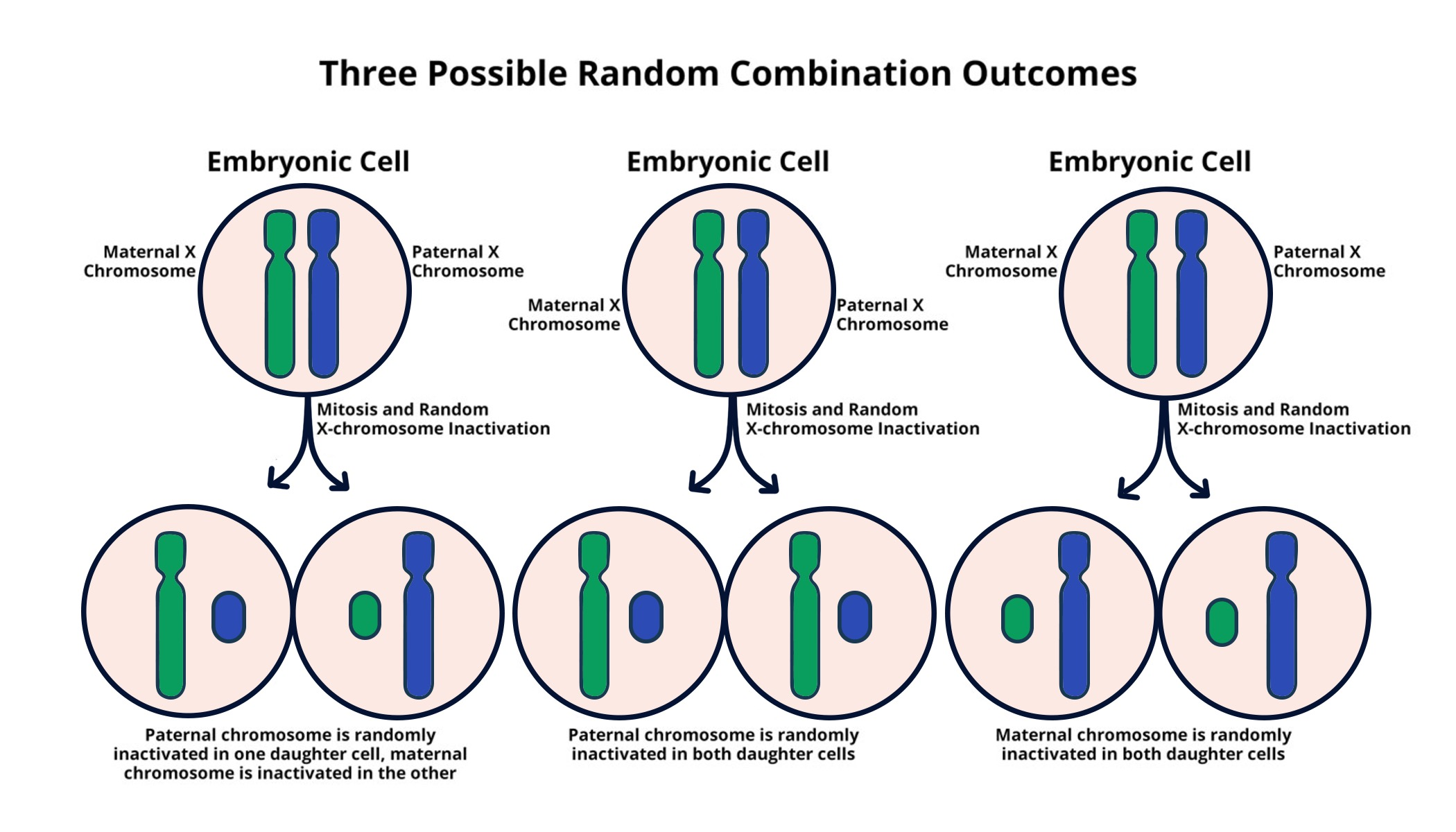
X Chromosome Inactivation: Key to Treating Genetic Diseases
X chromosome inactivation (XCI) is a crucial biological process that ensures females, who possess two X chromosomes, do not produce double the amount of X-linked gene products compared to males, who have only one. This phenomenon raises exciting implications for understanding and potentially treating genetic diseases, particularly those linked to mutations on the X chromosome like Fragile X Syndrome and Rett Syndrome. Recent research led by Jeannie T. Lee has unveiled how the Xist RNA molecule plays a pivotal role in orchestrating this complex silencing mechanism, providing insights that could be transformative in chromosomal research. As scientists explore the nuances of XCI, the potential to uncover innovative therapies for the thousands affected by these genetic disorders moves closer to reality. This exciting frontier represents both a synthesis of cutting-edge genetics and a hope for future advancements in medical treatments for X-linked conditions.
Also known as the process of X-inactivation, X chromosome silencing represents a remarkable biological adaptation within female cells, allowing them to balance gene expression between their two X chromosomes. This intricate evolutionary mechanism not only plays a critical role in normal development but also presents unique opportunities in addressing various chromosomal disorders linked to the X chromosome. Notably, conditions such as Fragile X syndrome and Rett syndrome exemplify the challenges that arise from mutations in X-linked genes, highlighting the importance of molecular players like Xist RNA in the inactivation process. Understanding the underpinnings of X-inactivation can illuminate new pathways for therapeutic interventions, particularly in diseases where the healthy gene remains dormant due to this chromosomal regulation. As research in this area progresses, the promise of genetic innovations to alleviate these often devastating conditions takes center stage.
Understanding X Chromosome Inactivation
X chromosome inactivation (XCI) is a fundamental process that occurs in female mammals, allowing for the dosage compensation of X-linked genes. Females possess two X chromosomes, while males carry only one. To balance gene expression between the sexes, one of the X chromosomes in females is randomly inactivated during early embryonic development. This inactivation is not merely a silencing of gene expression, but a highly regulated process involving complex molecular interactions, especially with the Xist RNA molecule, which plays a pivotal role in marking the chromosome for inactivation.
The cellular mechanisms surrounding XCI are intricate, involving a gelatinous substance that envelops chromosomes, facilitating the segregation of genetic material during cell division. Researchers like Jeannie T. Lee have highlighted the significance of this so-called ‘chromosomal Jell-O’ in the inactivation process. The Xist RNA molecule alters the properties of this gelatinous environment, enabling effective silencing of the chromosome. Understanding these mechanisms is crucial not only for basic biology but also for potential therapeutic interventions for disorders linked to mutations on the X chromosome.
The Role of Xist RNA in Genetic Disorders
Xist RNA is a key player in X chromosome inactivation, and its role extends beyond merely marking the X chromosome for silencing. In diseases such as Fragile X Syndrome and Rett Syndrome, mutations may reside on one of the two X chromosomes, leading to significant clinical manifestations. The ability to understand and manipulate Xist RNA could pave the way for innovative treatment strategies. By unsilencing the inactivated X chromosome, researchers hope to access healthy copies of genes that can compensate for the mutated versions, potentially providing relief for those affected by these genetic disorders.
Moreover, the research surrounding Xist RNA offers insights not only into underlying biological processes but also into therapeutic avenues that could transform the treatment landscape for genetic diseases. Current strategies developed by the Lee lab aim to optimize methods for restoring function in genes silenced by XCI, providing hope for future clinical applications. As studies progress, the prospect of utilizing Xist RNA to reverse the consequences of genetic mutations becomes an exciting frontier in personalized medicine.
Advancements in Treatments for Fragile X Syndrome
The recent advancements in understanding X chromosome inactivation hold great promise for treating Fragile X Syndrome, a condition characterized by intellectual disability and caused by mutations in the FMR1 gene. Research led by Jeannie T. Lee has demonstrated that by targeting the silenced X chromosome, it is possible to restore the expression of the healthy gene, which could alleviate some symptoms associated with the syndrome. The focus on developing pharmacological strategies to unsilence these genes reflects a shift towards more targeted genetic therapies that directly address the root causes of the disease.
Future clinical trials will be pivotal in determining the effectiveness and safety of these approaches. As Lee mentions, the prospect of optimizing these treatments is not only encouraging for those affected by Fragile X Syndrome but also illustrates a broader application potential for other genetic diseases linked to the X chromosome. Ongoing research and collaboration will be essential in translating laboratory findings into clinically relevant applications that could transform the lives of individuals with genetic disorders.
Exploring Treatments for Rett Syndrome
Rett Syndrome is another neurodevelopmental disorder linked to mutations on the X chromosome that could potentially benefit from advancements in X chromosome inactivation research. The Lee lab’s approach to unsilencing genes may provide a therapeutic pathway for individuals with Rett Syndrome, who often face severe impairments in cognitive and motor functions. Given that similar mechanisms of mutation in gene expression apply as those in Fragile X Syndrome, the lessons learned from one disorder may inform strategies for the other.
As research continues, scientists are exploring the molecular pathways that underpin Rett Syndrome, which could lead to targeted gene therapies that restore normal function. The goal is to leverage breakthroughs in chromosomal research to improve outcomes for patients with Rett Syndrome. By understanding the regulatory roles of Xist RNA and other associated molecules, future therapies may not only address symptoms but also potentially reverse the biological processes that lead to the disorder.
Chromosomal Research and Its Implications
Chromosomal research is essential for unraveling the complexities of genetic diseases, especially those associated with the X chromosome. The findings from Jeannie T. Lee’s lab highlight the innovative approaches being developed to study X chromosome inactivation and its physiological implications. By elucidating the mechanisms that drive X-inactivation, researchers are not only enhancing their understanding of basic biological processes but also opening doors to potential therapeutic strategies for combating genetic disorders.
The implications of this research extend far beyond individual diseases like Fragile X and Rett syndromes. As insights into chromosomal behaviors and the role of molecules such as Xist RNA deepen, researchers stand to gain a more comprehensive view of genetic regulation that could inform a wider array of treatments for various genetic disorders. This research is critical not only for patients suffering from specific conditions but also for advancing the broader field of genetics and therapeutic development.
The Importance of Gene Therapy Research
The pursuit of gene therapy as a viable treatment option for genetic disorders represents a significant frontier in modern medicine. With a focus on manipulating genes directly, research into X chromosome inactivation is generating vital insights into how gene therapy could be implemented in practice. The work being done on Xist RNA and chromosomal silencing reflects a growing understanding of the profound potential that gene therapy holds, particularly for diseases that have historically been viewed as challenging to treat.
Key to these advancements is the collaboration among geneticists, biologists, and medical researchers striving towards a common goal: developing effective interventions for patients. As Mesothelioma treatment has shown, innovative approaches in gene therapy have the ability to turn the tide in managing genetic diseases. The ongoing work related to X chromosome inactivation and the exploration of different therapeutic compounds will certainly contribute to the evolving landscape of gene therapy.
Clinical Trials and Future Prospects
As the research surrounding X chromosome inactivation matures, the transition from laboratory findings to clinical trials marks a crucial phase in the pursuit of effective genetic therapies. Jeannie T. Lee’s lab is actively optimizing their methodologies for unsilencing genes linked to X chromosome-related disorders, laying the groundwork for future clinical studies. These trials will be critical in determining which approaches yield positive patient outcomes and how best to integrate findings into existing medical frameworks.
The future prospects of these trials are promising, with the potential to revolutionize treatment for individuals with genetic disorders such as Fragile X and Rett syndromes. Continued funding and support for this type of research will enable scientists to chase after pragmatic solutions that not only address symptoms but also tackle the underlying genetic causes of these conditions. Ultimately, the scientific community’s commitment to advancing chromosomal research holds the key to unlocking new therapies that could significantly improve the quality of life for those affected.
Challenges in Genetic Research
While the advancements in X chromosome research present exciting opportunities for treatment, challenges still remain in the realm of genetic research. Understanding the intricacies of X chromosome inactivation is complex, requiring advanced techniques and collaborative efforts among scientists across various disciplines. The need for more comprehensive studies and analyses is crucial to ensure that the therapeutic approaches developed are both effective and safe for patients.
Another significant challenge lies in translating laboratory-based findings into effective clinical treatments. The pathway from bench to bedside is fraught with obstacles, including regulatory concerns, funding constraints, and the variability in human genetic expression. Addressing these issues will be key to successfully implementing new therapies that stem from innovations in the understanding of X-linked genetic diseases.
The Future of Chromosome-Based Therapies
The ongoing research into chromosome-based therapies, particularly concerning X chromosome inactivation, is set to revolutionize the treatment of various genetic diseases in the near future. The recent findings related to Xist RNA and its role in gene expression provide a foundation for developing therapies targeting conditions that have long been deemed difficult to manage. As scientists continue to refine these methods, the horizon looks promising for novel treatments addressing not just Fragile X Syndrome and Rett Syndrome but a broader spectrum of genetic disorders.
Going forward, it is crucial to continue investing in chromosomal research and fostering interdisciplinary collaboration. The integration of knowledge from genetics, molecular biology, and therapeutic development will be essential in creating effective solutions for genetic diseases. With innovative approaches taking shape, the landscape of genetic therapy can shift significantly, offering hope and tangible solutions to countless individuals affected by such disorders.
Frequently Asked Questions
What is X chromosome inactivation and how does it relate to genetic diseases?
X chromosome inactivation is a biological process that occurs in female mammals where one of the two X chromosomes is silenced to ensure that gene expression levels are balanced between males (who have one X chromosome) and females. This process is crucial in understanding genetic diseases linked to the X chromosome, such as Fragile X Syndrome and Rett Syndrome. By studying X chromosome inactivation, researchers hope to develop therapies that can ‘unsilence’ these genes for patients with X-linked disorders.
How does Xist RNA molecule contribute to X chromosome inactivation?
The Xist RNA molecule plays a pivotal role in X chromosome inactivation by coating the X chromosome and altering the properties of the surrounding chromosomal material, often described as ‘Jell-O’. This interaction helps to silence the chromosome, preventing the expression of genes that could lead to disease. Understanding how Xist functions offers insight into potential therapies for genetic diseases like Fragile X Syndrome.
Which disorders are associated with mutations on the X chromosome that could be impacted by X chromosome inactivation research?
Research into X chromosome inactivation is particularly relevant for disorders such as Fragile X Syndrome and Rett Syndrome, which are caused by mutations on the X chromosome. These genetic diseases can be linked to the disruption of normal gene function on this chromosome, and advances in understanding X chromosome inactivation may lead to breakthrough therapies.
Can releasing inactivated X chromosomes cure genetic diseases linked to the X chromosome?
Yes, research indicates that releasing inactivated X chromosomes could potentially cure genetic diseases linked to the X chromosome. This is because many mutations related to these diseases impact only one X chromosome, allowing the healthy copy to be utilized if the inactivation is lifted. This strategy could lead to effective treatments for conditions such as Fragile X Syndrome and Rett Syndrome.
What role does chromosomal research play in addressing issues related to X chromosome inactivation?
Chromosomal research is essential for unraveling the complexities of X chromosome inactivation. By studying how Xist RNA and other molecules work together to silence one of the X chromosomes in females, scientists are beginning to develop potential treatments for genetic disorders tied to this phenomenon. Ongoing research in this area holds promise for advancing therapies targeting diseases like Fragile X Syndrome and Rett Syndrome.
| Key Concepts | Details |
|---|---|
| X Chromosome Inactivation | Occurs in females to silence one of the two X chromosomes to balance gene dosage with males who have one X. |
| Role of Xist | An RNA molecule that modifies the surrounding ‘Jell-O’ substance, leading to the inactivation of one X chromosome. |
| Therapeutic Potential | Research by Jeannie T. Lee may allow unsilencing of mutated X-linked genes, leading to treatments for disorders like Fragile X and Rett syndromes. |
| Fundamental Research | Decades of study funded by NIH focused on understanding X chromosome inactivation mechanisms to open pathways for clinical applications. |
Summary
X chromosome inactivation is a critical biological process that ensures balanced gene expression in females and males. By silencing one of the two X chromosomes in females, the process allows for normal development and function. Recent breakthroughs in understanding the mechanisms behind this inactivation, particularly through the work of Jeannie T. Lee, suggest promising therapies for genetic disorders linked to the X chromosome. These emerging treatments could potentially unsilence mutated genes, offering hope for individuals suffering from conditions like Fragile X and Rett syndromes while maintaining the integrity of healthy genes. As research continues, the implications of X chromosome inactivation extend beyond basic science into transformational medical therapies.



